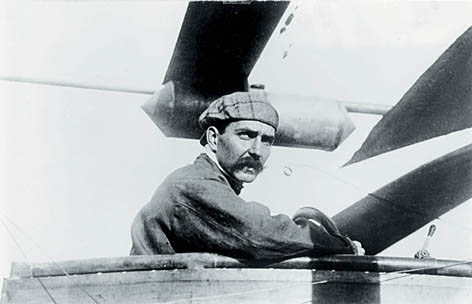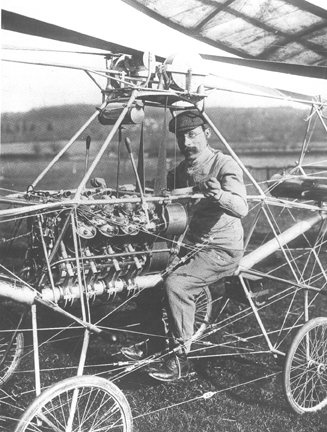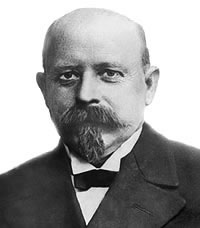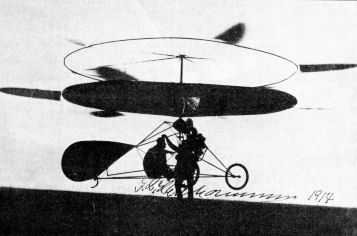<Back to Index>
- Aircraft Designer and Builder Louis Charles Breguet, 1880
- Engineer Paul Cornu, 1881
- Watchmaker and Inventor Jacob Christian Hansen Ellehammer, 1871
PAGE SPONSOR

Louis Charles Breguet (January 2, 1880 in Paris - May 4, 1955 in Saint - Germain - en - Laye, France) was a French aircraft designer and builder, one of the early aviation pioneers.
In 1902, Louis married Nelly Girardet, the daughter of painter Eugene Girardet. They had five children together.
In 1905, with his brother Jacques, and under the guidance of Charles Richet, he began work on a gyroplane (the forerunner of the helicopter) with flexible wings. It achieved the first ascent of a vertical flight aircraft with a pilot in 1907. He built his first fixed wing aircraft, the Breguet Type I in 1909, flying it successfully before crashing it at the Rheims Aviation Meeting. In 1911 he founded the Société Anonyme des Ateliers d'Aviation Louis Breguet. In 1912, Breguet constructed his first hydroplane.
He is especially known for his development of reconnaissance aircraft used by the French in World War I and through the 1920s. One of the pioneers in the construction of metal aircraft, the Breguet 14 day bomber, perhaps the most famous French warplane of all time, was made almost entirely of aluminium. As well as the French, sixteen squadrons of the American Expeditionary Force also used it. A plane of this type has a major role in the plot of the 1927 thriller So Disdained by Nevil Shute.
In 1919, he founded the Compagnie des Messageries Aeriennes, which evolved into Air France.
Over the years, his aircraft set several records. A Breguet plane made the first nonstop crossing of the South Atlantic in 1927. Another made a 4,500 mile (7,200 km) flight across the Atlantic Ocean in 1933, the longest nonstop Atlantic flight up to that time.
He returned to his work on the gyroplane in 1935. Created with co-designer René Dorand, the craft, called the Gyroplane Laboratoire, flew by a combination of blade flapping and feathering. On December 22, 1935, it established a speed record of 67 mph (108 km/h). It was the first to demonstrate speed as well as good control characteristics. The next year, it set an altitude record of 517 feet (158 m).
Breguet remained an important manufacturer of aircraft during World War II and afterwards developed commercial transports. Breguet’s range equation, for determining aircraft range, is also named after him. He died of a heart attack in 1955 at Saint - Germain - en - Laye.
Breguet, as helmsmen of his 8 Metre yacht Namousa, won a bronze medal in sailing during the 1924 Summer Olympics.

Paul Cornu (June 15, 1881 – 6 June 1944) was a French engineer who manufactured bicycles by trade.
French engineer Paul Cornu designed the world's first manned rotary wing aircraft and made the first piloted free flight with it at Lisieux, Calvados, France, on November 13, 1907. This first flight lifted Cornu about 30 cm (1 ft) and lasted 20 seconds. This is sometimes recognized as the first free (but impractical) helicopter flight with a passenger. This first helicopter was powered by a 24 horsepower (18 kW) Antoinette engine.
The helicopter was not maneuverable however, and the construction was abandoned after a few flights.
Previously, a French helicopter, the Breguet - Richet Gyroplane I, had managed to lift off by its own power, but it had been held in position by men standing on the ground.
Paul Cornu died in 1944 in Lisieux, France, when his home was destroyed during the bombardment that accompanied the Normandy landings.


Jacob Christian Hansen Ellehammer (June 14, 1871 – May 20, 1946) was a Danish watchmaker and inventor born in Bakkebřlle, Denmark. He is remembered chiefly for his contributions to powered flight.
Following the end of his apprenticeship as a watchmaker he moved to Copenhagen where he worked as an electronics mechanic before establishing his own company in 1898. In the beginning he produced cigarette machines, beverage machines and other electronic machinery. In 1904 he produced his first motorcycle, the Elleham motorcycle. In 1905, he constructed a monoplane, and in the following year a "semi - biplane". In this latter machine, he made a tethered flight on 12 September 1906.
Ellehammer's later inventions included a successful triplane and helicopter. His helicopter was a coaxial machine. A famous photo shows it hovering in 1914, though there is no evidence that it was successful in achieving translational flight. Ellehammer later studied a disc - rotor configuration - a compound helicopter with coaxial blades that extended from the hub for hover, and retracted for high speed vertical flight. Although a wind tunnel model was constructed, there's no evidence that anything more was studied.